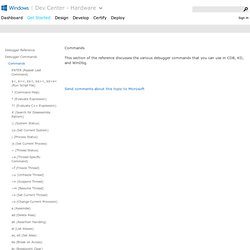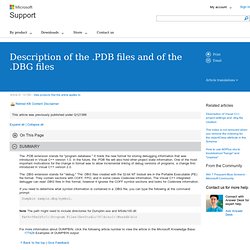

Iczelion's Win32 Assembly Tutorial 28: Win32 Debug API Part 1. Win32 debugger. Dashboard Get Started Design Develop Certify Deploy Sign in Commands This section of the reference discusses the various debugger commands that you can use in CDB, KD, and WinDbg.

Show: Was this page helpful? Your feedback about this content is important.Let us know what you think. Additional feedback? Thank you! We appreciate your feedback. Centers Related developer sites Other Windows sites Downloads Support Essentials Stay connected © 2014 Microsoft. Description of the .PDB files and of the .DBG files. The .PDB extension stands for "program database.

" It holds the new format for storing debugging information that was introduced in Visual C++ version 1.0. In the future, the .PDB file will also hold other project state information. One of the most important motivations for the change in format was to allow incremental linking of debug versions of programs, a change first introduced in Visual C++ version 2.0. The .DBG extension stands for "debug. " The .DBG files created with the 32-bit NT toolset are in the Portable Executable (PE) file format. If you need to determine what symbol information is contained in a .DBG file, you can type the following at the command prompt: Dumpbin sample.dbg/symbol. Note The path might need to include directories for Dumpbin.exe and MSdis100.dll: Path=%Path%;C:\Program Files\DevStudio\VC\bin;C:\Msssdk\bin For more information about DUMPBIN, click the following article number to view the article in the Microsoft Knowledge Base: ( ) Examples of DUMPBIN output.
DbgHelp Functions. Debug PDB files, eh symbol tables? can they be read?. Debug Interface Access SDK. Querying the .pdb File. /Gh (Enable _penter Hook Function) (C++) Causes a call to the _penter function at the start of every method or function.

The _penter function is not part of any library and it is up to you to provide a definition for _penter. Unless you plan to explicitly call _penter, you do not need to provide a prototype. The function must appear as if it had the following prototype, and it must push the content of all registers on entry and pop the unchanged content on exit: void __declspec(naked) _cdecl _penter( void ); This declaration is not available for 64-bit projects. To set this compiler option in the Visual Studio development environment.
A Simple Profiler using the Visual Studio C/C++ Compiler and DIA. Introduction As a C++ programmer, I always end up writing code for products which are either add-on applications or third-party DLLs to the main application.

So as a developer, it's important for me to ensure that my code does not degrade the performance of the main application or product. Generally, I use commercial products like IBM Rational Product Suite or Bounds Checker. But at times, these commercial tools are not useful as the code (DLL) which I write relies on the main application as the main application is not at all modifiable for profiling. The Art of Picking Intel Registers. I wrote this article for an online magazine called Scene Zine.

Scene Zine caters to the Demo Scene, which is an digital art community dedicated to pushing the limits of computers through a mix of music, art, and computer programming. A particular category of demoscene productions, 4K intros, focus on the final production's raw file size. The goal is to put as much high-quality music, graphics, and animation as possible into only 4096 bytes. Doing this requires highly-specialized size optimization techniques, since 4096 bytes is less space than two pages of typed text or a true-color Windows XP icon. This article discusses some of these techniques. Some people have commented that they want to see more expert programming articles in Scene Zine. When the engineers at Intel designed the original 8086 processor, they had a special purpose in mind for each register. Using the registers consistently has other advantages besides size optimization.
Each register name is really an acronym.